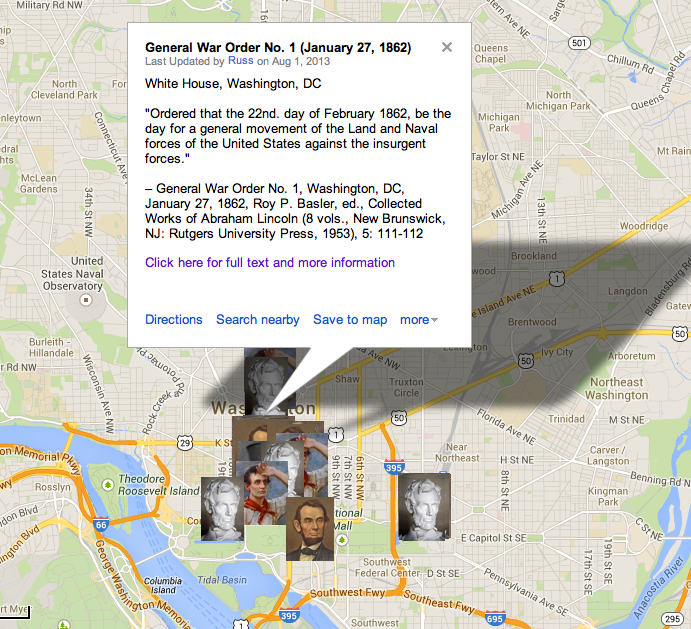Contributing Editors for this page include Wind Ralston
Ranking
#59 on the list of 150 Most Teachable Lincoln Documents
Annotated Transcript
On This Date
HD Daily Report, January 27, 1862
The Lincoln Log, January 27, 1862
Custom Map
Close Readings
Posted at YouTube by “Understanding Lincoln” course participant Wind Ralson, September 2014
How Historians Interpret
“The president had waited patiently – and in vain – for McClellan’s plan of operations and, like the electorate, he was growing restless. ‘It is wonderful how public opinion is changing against McClellan,’ an Ohioan reported in late February. An editor quipped that he had no time to look over the many monthly magazines he received and was tempted to send them to Little Mac, ‘whose forte seemed to be reviewing.’ To smoke the general out, Lincoln resorted to an unusual expedient: on January 27, he issued ‘President’s General War Order No. 1,’ commanding all land and naval forces to begin a “general movement” against the enemy on George Washington’s birthday, February 22. (Privately, Stanton explained that ‘the Government was on the verge of bankruptcy, and at the rate of expenditure, the armies must move or the Government perish.’) As Hay observed, the issuance of this general war order marked a turning point: ‘He wrote it without any consultation and read it to the Cabinet, not for their sanction but for their information. From that time he influenced actively the operations of the Campaign. He stopped going to McClellan’s and sent for the general to come to him. Every thing grew busy and animated after this order.’ When the order was released to the press in March, the Cincinnati Gazette called it ‘the stroke that cut the cords which kept our great armies tied up in a state of inactivity.’”
— Michael Burlingame, Abraham Lincoln: A Life (2 volumes, originally published by Johns Hopkins University Press, 2008) Unedited Manuscript by Chapter, Lincoln Studies Center, Volume 2, Chapter 26 (PDF), 2829-2830.
“Although it appears that Lincoln intended his active involvement in military planning to be no more than a temporary expedient while McClellan was ill, the president never stepped back completely. McClellan subsequently attempted to exercise what he perceived from previous experience to be his responsibilities as general in chief. However, he found the autonomy he had previously enjoyed severely diminished, as Lincoln began directly challenging his conduct of military affairs through such actions as the issuance of President’s War Order No. 1 on January 27, setting a date for a general advance, and a special order on January 31 establishing the Army of the Potomac’s line of operations. Although both orders were ultimately rescinded, the tension and conflict produced by Lincoln’s new assertiveness, along with Stanton’s radical influence on the War Department, poisoned relations between the president and the general in chief. Their relationship deteriorated dramatically over the next few months and, by the time he began his grand campaign to crush the rebellion in March 1862, McClellan no longer possessed the trust and support he needed to achieve success on the battlefield.”
— Ethan S. Rafuse, “Typhoid and Tumult: Lincoln’s Response to General McClellan’s Bout with Typhoid Fever during the Winter of 1861-62,” Journal of the Abraham Lincoln Association 18, no. 2 (1997): 1-16.
“Lincoln’s two war orders, dated January 27 and January 31, intended only for the eyes of General McClellan and the secretaries of war and navy, have been widely criticized by historians as intrusive interference in war operations. John Codman Ropes, writing in 1894, described the General War Order No. 1 of January 27 as ‘a curious specimen of puerile impatience.’ What is often overlooked, however, is the purpose behind these two order (General War Order No. 1 specified ‘a general movement of the Land and Naval forces’ to take place on February 22; Special War Order No. 1 of January 31 ordered the execution of the Occoquan plan) Since his appointment on November 1, General-in-chief McClellan had only hinted at his strategic plans, and that rarely, or had flatly refused to divulge them even in the most general outline. It was true enough that Virginia was in the grip of its notorious mud season and that no general advance could now begin there before spring, yet to date no one in either the military or the civilian branch of the government (no one except General McClellan) knew if there was a single word on paper for what would prove to be the largest military operation of the war. Mr. Lincoln’s war orders did indeed signal his impatience, but there was nothing puerile about them. They served their purpose very nicely.”
“Lincoln and McClellan,” Stephen W. Sears in Lincoln’s Generals, ed. Gabor S. Boritt (New York: Oxford University Press, 1994).
NOTE TO READERS
This page is under construction and will be developed further by students in the new “Understanding Lincoln” online course sponsored by the House Divided Project at Dickinson College and the Gilder Lehrman Institute of American History. To find out more about the course and to see some of our videotaped class sessions, including virtual field trips to Ford’s Theatre and Gettysburg, please visit our Livestream page at http://new.livestream.com/gilderlehrman/lincoln

